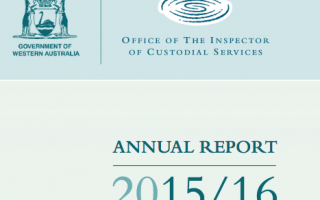OICS Report highlights the extent of overcrowding in WA prison system
Wednesday 07 Dec 2016
A new report from the Office of the Inspector of Custodial Services has highlighted the significant increase in Western Australia’s prison population, with concerns about the capacity of current prisons to handle the growing number of inmates.
WAPOU has been highlighting these problems for well over two years now, and we are pleased to see the OICS shares our concerns. This report vindicates WAPOU’s position, and we will use the statistics in the report to continue to pursue the government on this issue.
The report reveals there was a 770 person increase in the WA prison population between July 2015 to July 2016, and an increase of 1,083 people since 2014. To put this number into context, as many of you may know, Acacia has a total capacity of around 1,475.
The report identifies the dramatic increase in remand prisoners as a key source of the growth. The number of remand prisoners has been growing at a faster rate than sentenced prisoners for a number of years now, but over the last 12 months there has been a 44 per cent increase in remand prisoner numbers, from 1,277 on 1 July 2015 to 1,835 on 1 July 2016. This means that remand prisoners now make up almost 30% of the prison population, up from 17 per cent ten years ago.
Neither of the state’s primary remand facilities, Bandyup and Hakea, are able to meet the current demand, with both currently under immense pressure due to overcrowding, which is creating an incredibly difficult environment for the hard working staff.
Insufficient capacity at these facilities has forced other prisons with infrastructure and operations designed for sentenced prisoners to handle a growing number of remandees. This has created significant pressure at these facilities, especially at Casuarina Prison, and management and staff deserve recognition and credit for the pragmatic way they have adjusted their practices and attempted to continue to provide services.
Remand prisoners must be a priority in government planning of future prison construction. They must also be given more support services, both in prison and on release.
The OICS report specifically highlights this fact:
“Given the state of crowding in the system it is clear that Western Australia needs a new prison. In our view, this needs to be made multi-purpose, with a primary focus on remand prisoners and other identified cohorts, such as people with mental health needs.”
As we have previously highlighted, there is currently no provision for a new prison in the state budget’s forward estimates, and it is hard to see how the population growth will be managed.
The report goes on to mention with no facilities planned in the future (and if planning were to commence now, the facilities would not be ready until into the 2020s), the state prison system is at risk due to overcrowding and services being stretched, putting even more pressure on staff.
Additional accommodation will undoubtedly be added to already stretched and crowded facilities. The report points out that this is a “short term measure” at best and is a strategy that poses “significant risks”. Even if you agree with their definition of what constitutes maximum operating capacity, the model suggests facilities are already housing prisoners at a rate of 148% of maximum operating capacity. It’s safe to assume key amongst those risks will be an elevated risk of assaults on staff.
What we really want to know is: how does the State Government intend to reduce the risk of assaults on staff and manage the prison overcrowding crisis it now faces, if there are no new facilities planned?
The OICS report raises further questions about how the government intends to tackle the disproportionate Aboriginal incarceration rates and the rapid growth in female and remand numbers, and what community initiatives it has planned to target reducing these vulnerable populations within the WA prison system?
